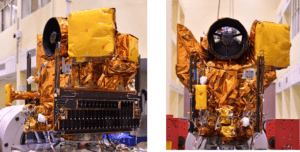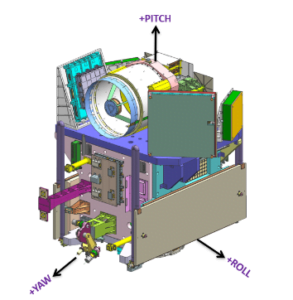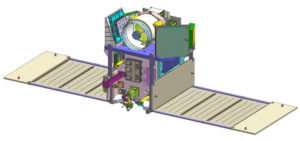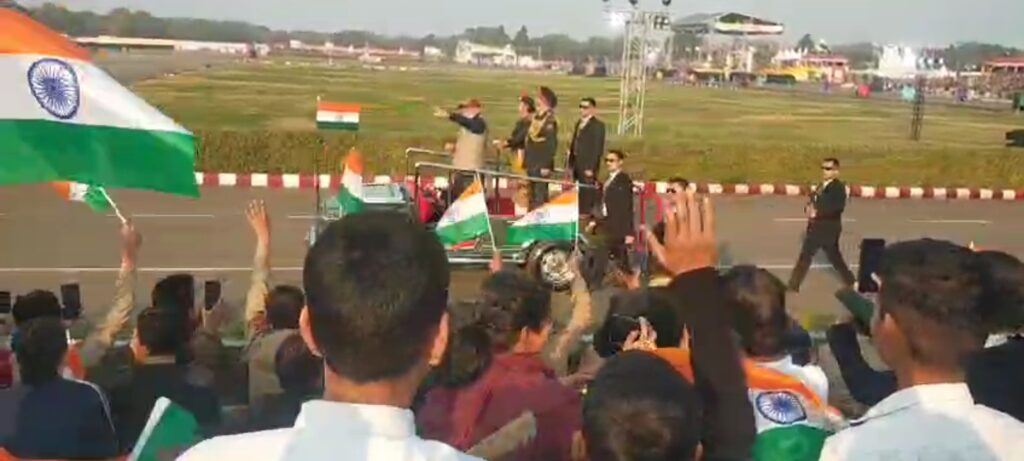India Launches SSLV-D3/EOS-08 Microsatellite on 15 August 2024 from Sriharikota, Andhra Pradesh
On 15 August 2024, India marked another significant achievement in its space exploration journey by successfully launching the SSLV-D3/EOS-08 microsatellite from the Satish Dhawan Space Centre (SDSC) in Sriharikota, Andhra Pradesh. This mission, conducted at 9:17 AM IST, symbolizes India’s continued dedication to enhancing its space capabilities, underscoring the country’s growing expertise in satellite technology and space exploration.

SSLV’s third and final developmental flight will launch the EOS-08 microsatellite for ISRO on August 15, 2024, at 09:17 IST from SDSC-SHAR, Sriharikota. This flight completes the SSLV Development Project and enables operational missions by Indian industry and NSIL.
regard’s by : ISRO
A Historical Perspective on India’s Space Endeavors
India’s space program, initiated by the Indian Space Research Organisation (ISRO) in the early 1960s, has consistently evolved to become one of the most robust and reliable programs globally. From the humble beginnings with the launch of Aryabhata, India’s first satellite, in 1975, ISRO has achieved remarkable milestones, including the Mars Orbiter Mission (Mangalyaan), the Chandrayaan missions, and the continuous development of satellite launch vehicles like the Polar Satellite Launch Vehicle (PSLV) and the Geosynchronous Satellite Launch Vehicle (GSLV).
The SSLV-D3 (Small Satellite Launch Vehicle – Developmental Flight 3) represents a new era in India’s space program. This microsatellite launch vehicle is designed to cater to the increasing demand for launching small satellites, which are critical for a variety of applications, including earth observation, communication, and scientific research. The SSLV-D3 is part of ISRO’s initiative to develop cost-effective and flexible launch vehicles that can serve both domestic and international customers.
The Evolution of SSLV: From Concept to Reality
The SSLV program was conceived to address the growing need for a quick, cost-effective, and efficient method to launch small satellites into low earth orbit (LEO). Unlike the larger and more complex PSLV and GSLV, which are used for launching heavier payloads and satellites into geosynchronous orbits, the SSLV is designed specifically for small payloads. This makes it an ideal solution for the booming market of nanosatellites and microsatellites, which are increasingly being used for a wide range of applications, including climate monitoring, disaster management, and remote sensing.
The development of the SSLV began in the late 2010s, with the first developmental flight, SSLV-D1, taking place in August 2022. Although the maiden flight experienced some challenges, ISRO swiftly addressed the issues and successfully launched SSLV-D2 in February 2023. These initial flights provided valuable insights and data, which were instrumental in refining the SSLV design and ensuring the success of subsequent missions.
The SSLV-D3/EOS-08 Mission: Objectives and Significance
The primary objective of the SSLV-D3/EOS-08 mission was to demonstrate the vehicle’s capability to place a microsatellite into a precise orbit. The mission aimed to validate the SSLV’s performance parameters, including its flexibility, cost-effectiveness, and quick turnaround time. The successful launch of SSLV-D3 represents a significant milestone in India’s space program, as it confirms the vehicle’s readiness for operational missions.
The EOS-08 microsatellite, the payload for this mission, is part of ISRO’s Earth Observation Satellite (EOS) series. This satellite is designed to provide high-resolution imagery for a variety of applications, including agriculture, forestry, urban planning, and disaster management. The data collected by EOS-08 will be invaluable for government agencies, research institutions, and private sector entities, enabling them to make informed decisions based on accurate and timely information.
Technical Specifications and Innovations of SSLV-D3
The SSLV-D3 is a three-stage solid-propellant rocket, designed to be highly flexible and capable of launching payloads of up to 500 kilograms into low earth orbit. The vehicle stands approximately 34 meters tall, with a diameter of 2 meters, making it significantly smaller and more compact than the PSLV and GSLV. This compact design allows for easier transportation and assembly, reducing the overall launch preparation time.
One of the key innovations in the SSLV program is its modular design, which enables rapid assembly and integration. The SSLV can be assembled and launched within a short period, making it an ideal solution for missions that require quick turnaround times. Additionally, the vehicle’s simplified design and fewer components reduce the risk of technical failures, enhancing its reliability.
Another notable feature of the SSLV-D3 is its ability to perform multiple orbital insertions in a single mission. This capability is particularly useful for deploying satellite constellations, where multiple satellites need to be placed in different orbits. The SSLV’s versatility and adaptability make it a valuable asset for both ISRO and its international customers, as it can be tailored to meet specific mission requirements.
The Launch Process: A Step-by-Step Overview

1. *Pre-Launch Preparations:*
– In the weeks leading up to the launch, the SSLV-D3 vehicle and the EOS-08 microsatellite were transported to the launch site at SDSC, Sriharikota. The vehicle underwent a series of rigorous tests, including static fire tests of its solid rocket motors, to ensure that all systems were functioning optimally.
– The satellite was integrated with the launch vehicle in a cleanroom environment, where engineers conducted final checks on the payload and ensured that it was securely attached to the rocket’s payload adapter.
2. *Launch Countdown:*
– On the day of the launch, the countdown process began several hours before the scheduled liftoff time. During this period, engineers closely monitored the vehicle’s systems, including its propulsion, avionics, and telemetry systems.
– The launch director and mission control teams conducted a final review of the weather conditions and confirmed that the launch window was optimal for a successful mission.
3. *Ignition and Liftoff:*
– At precisely 9:17 AM IST, the SSLV-D3’s first stage solid rocket motor ignited, generating a thrust of approximately 260 kilonewtons. The vehicle lifted off from the launch pad and began its ascent into the sky.
– The first stage burned for about 1 minute and 50 seconds, propelling the rocket to an altitude of approximately 50 kilometers. After the first stage burnout, it was jettisoned, and the second stage ignited to continue the ascent.
4. *Stage Separation and Orbital Insertion:*
– The second stage burned for approximately 2 minutes and 30 seconds, followed by the ignition of the third stage, which continued to propel the vehicle towards its target orbit.
– Once the vehicle reached the designated altitude and velocity, the third stage was jettisoned, and the satellite deployment sequence was initiated.
5. *Satellite Deployment:*
– The EOS-08 microsatellite was successfully deployed into a sun-synchronous orbit (SSO) at an altitude of approximately 500 kilometers above the Earth’s surface. The satellite’s onboard systems were activated, and it began transmitting data back to the ground control stations.
6. *Post-Launch Operations:*
– Following the successful deployment of EOS-08, the satellite’s health and status were continuously monitored by ISRO’s ground control teams. Over the next few days, the satellite’s orbit was fine-tuned, and its instruments were calibrated to ensure optimal performance.
The Role of Sriharikota in India’s Space Program
The Satish Dhawan Space Centre (SDSC) in Sriharikota has been the launch site for all of India’s major space missions since the 1970s. Located on the east coast of India, in the state of Andhra Pradesh, SDSC is ideally situated for launching satellites into polar and geosynchronous orbits. The proximity to the equator allows for greater launch efficiency, enabling rockets to carry heavier payloads.
Sriharikota has witnessed numerous historic launches, including the Chandrayaan and Mangalyaan missions, as well as the record-setting PSLV-C37 mission, which successfully deployed 104 satellites in a single launch. The launch of SSLV-D3/EOS-08 adds to this legacy, highlighting the critical role that SDSC plays in advancing India’s space capabilities.
The Impact of SSLV-D3/EOS-08 on India’s Space Industry
The successful launch of SSLV-D3/EOS-08 has far-reaching implications for India’s space industry. First and foremost, it demonstrates ISRO’s ability to develop and deploy small satellite launch vehicles that are competitive on a global scale. This achievement will likely attract more international customers to ISRO’s commercial arm, Antrix Corporation, boosting India’s share in the global space launch market.
Furthermore, the SSLV program aligns with the Indian government’s broader vision of promoting indigenous innovation and self-reliance in the space sector. By developing cost-effective and versatile launch vehicles like the SSLV, India is reducing its dependence on foreign launch services and strengthening its position as a leading space-faring nation.
The data provided by the EOS-08 microsatellite will also contribute to India’s socio-economic development. High-resolution imagery from EOS-08 can be used for a wide range of applications, including precision agriculture, urban planning, natural resource management, and disaster response. These capabilities will enhance the government’s ability to address critical challenges, such as food security, environmental conservation, and climate change.
The Global Implications of SSLV-D3’s Success
The SSLV-D3/EOS-08 mission has garnered significant attention from the global space community. The successful launch of a small satellite using a dedicated microsatellite launch vehicle positions India as a key player in the rapidly growing small satellite market.
As more countries and private companies seek to deploy small satellites for various purposes, India’s SSLV-D3 offers a reliable, cost-effective solution that can meet these demands. This success not only enhances India’s reputation in space technology but also opens up new avenues for international collaboration and partnerships.
The Future of Small Satellite Launches
The global space industry is witnessing a paradigm shift, with small satellites playing an increasingly important role. These small, agile satellites are being used for a myriad of applications, ranging from Earth observation and communication to scientific research and technology demonstrations. The demand for launching these satellites into space is growing rapidly, and countries like India are well-positioned to capitalize on this trend.
With the successful launch of SSLV-D3, ISRO has demonstrated its readiness to tap into the burgeoning small satellite market. The SSLV’s ability to offer quick turnaround times and flexibility makes it an attractive option for international clients who require timely and cost-efficient launches. Moreover, the vehicle’s modular design and adaptability ensure that it can cater to a wide range of mission profiles, further increasing its appeal.
Looking ahead, ISRO is likely to focus on expanding the capabilities of the SSLV program. This could involve enhancing the payload capacity, improving the vehicle’s performance, and developing new technologies that allow for even greater flexibility and cost savings. Additionally, ISRO may explore the possibility of launching multiple small satellites simultaneously, enabling customers to deploy entire satellite constellations in a single mission.
International Collaborations and Partnerships
The SSLV-D3/EOS-08 mission also underscores the potential for international collaborations in the space sector. As more countries and private entities look to launch small satellites, there is an opportunity for India to forge partnerships with other space agencies and commercial players. These collaborations could involve joint missions, technology sharing, and the development of new launch services that cater to the specific needs of international customers.
ISRO has a long history of collaborating with other space agencies, including NASA, the European Space Agency (ESA), and the Russian space agency Roscosmos. These partnerships have resulted in successful missions, such as the Chandrayaan-1 mission, which carried instruments from NASA and ESA, and the Mars Orbiter Mission, which benefited from international cooperation. The SSLV program could serve as a platform for further strengthening these ties and exploring new avenues for collaboration.
India’s Role in the Global Space Economy
The successful launch of SSLV-D3/EOS-08 is a testament to India’s growing influence in the global space economy. As the space industry continues to evolve, India is emerging as a key player, offering a range of services and technologies that are highly competitive on the world stage. The country’s ability to develop and deploy small satellite launch vehicles, coupled with its expertise in satellite manufacturing and mission management, positions it as a leading provider of space solutions.
India’s space sector has also attracted significant interest from the private sector, both domestically and internationally. The government’s push for space sector reforms, including the establishment of the Indian National Space Promotion and Authorization Center (IN-SPACe), has opened up new opportunities for private companies to participate in space activities. This has led to the emergence of a vibrant ecosystem of startups and entrepreneurs, who are developing innovative technologies and services that complement ISRO’s capabilities.
The SSLV-D3/EOS-08 mission highlights the synergies between the public and private sectors in India, and how these collaborations can drive the country’s space ambitions forward. As the global demand for space-based services continues to grow, India’s space industry is well-positioned to capture a significant share of the market and contribute to the country’s economic growth.
Challenges and Future Prospects
While the success of SSLV-D3/EOS-08 is a significant achievement, it is important to recognize the challenges that lie ahead. The global space industry is highly competitive, with numerous players vying for market share.
Enhancing India’s Space Diplomacy
The SSLV-D3/EOS-08 mission is more than just a technological achievement; it is also a significant diplomatic tool. India’s space program has always been a source of national pride and international respect. By showcasing its ability to develop and launch small satellite vehicles like the SSLV, India can further strengthen its ties with other nations, especially those that are looking to develop or expand their own space capabilities but may lack the necessary infrastructure or experience.
The successful deployment of the EOS-08 microsatellite demonstrates India’s capability to offer launch services that are not only cost-effective but also reliable. This success is likely to attract more countries, especially developing nations, to collaborate with ISRO for their space missions. Such collaborations could involve everything from launching small satellites to sharing data and technology, ultimately boosting India’s status as a leader in space technology.

India’s space diplomacy is not just limited to launching satellites for other countries. The data from EOS-08, for instance, could be shared with other nations, particularly those in the South Asian region, to help them in areas such as disaster management, agricultural planning, and urban development. By offering such valuable resources, India can strengthen its regional influence and build stronger alliances.
The Strategic Importance of the SSLV Program
The SSLV program is also strategically important for India. In an era where space is increasingly seen as the next frontier for both economic and military competition, having a reliable and flexible launch vehicle like the SSLV gives India a significant advantage. The ability to quickly launch small satellites into space could prove crucial in times of geopolitical tension, where satellite-based surveillance and communication capabilities could be a game-changer.
Moreover, the SSLV’s versatility in launching satellites for various purposes—be it for scientific research, earth observation, or even potential military applications—adds another layer of strategic value to India’s space program. As space becomes an increasingly contested domain, having such a capability will be critical for maintaining national security and sovereignty.
The Road Ahead for ISRO and SSLV
The successful launch of SSLV-D3/EOS-08 is a strong validation of the efforts and investments that have gone into developing this new class of launch vehicles. However, this is just the beginning. ISRO has ambitious plans for the future, including scaling up the SSLV program to make it a staple of India’s space launch offerings.
One of the key areas where ISRO is likely to focus is on making the SSLV even more cost-effective and efficient. This could involve the use of new materials, advanced propulsion technologies, and more streamlined manufacturing processes. Additionally, ISRO may look to increase the payload capacity of the SSLV, enabling it to carry larger or multiple satellites in a single launch.
Another potential avenue for development is the commercialization of the SSLV program. With the global space industry expected to grow rapidly over the next decade, there is a significant opportunity for ISRO to capture a larger share of the small satellite launch market. By offering competitive pricing, quick turnaround times, and reliable service, the SSLV could become the go-to vehicle for international customers looking to launch small satellites.
A Proud Moment for India
The launch of SSLV-D3/EOS-08 on 15 August 2024 is a moment of immense pride for India. It showcases the country’s growing capabilities in space technology and reaffirms its position as a leader in the global space community. The successful deployment of the EOS-08 microsatellite not only serves as a testament to the skill and dedication of India’s scientists and engineers but also underscores the country’s commitment to pushing the boundaries of space exploration.
As India celebrates this achievement, it is also a time to reflect on the journey that has brought the country to this point. From the early days of the space program to the successful missions of recent years, ISRO has consistently demonstrated its ability to innovate and achieve remarkable results. The SSLV-D3/EOS-08 mission is the latest chapter in this story of success, and it promises to be a significant milestone in India’s ongoing quest to explore and harness the potential of space.
# Vegetarian Diet Plan 2024 : look here your best diet.
Conclusion: A New Horizon for India’s Space Ambitions
The successful launch of the SSLV-D3/EOS-08 microsatellite marks a pivotal moment in India’s space program. It is a clear demonstration of the country’s ability to design, build, and launch cost-effective small satellite vehicles, placing it at the forefront of the global space race. The mission is not only a technological success but also a symbol of India’s growing stature in the international arena, where it continues to play a crucial role in space exploration and satellite technology.
As India looks to the future, the SSLV program will undoubtedly play a key role in shaping the next phase of the country’s space endeavors. With its ability to launch small satellites quickly and cost-effectively, the SSLV will be a critical tool in meeting both the domestic and international demands for satellite launches.
Moreover, it will strengthen India’s strategic position, providing the country with a flexible and reliable launch capability that can be used for a wide range of purposes.
# Best Electric Cars in India 2024 : look some cars according your budget.
The SSLV-D3/EOS-08 mission is more than just a successful launch; it is a stepping stone towards a new horizon for India’s space ambitions. As ISRO continues to innovate and expand its capabilities, there is no doubt that India will remain a key player in the global space industry, leading the way in both technological advancements and international collaborations. The future is bright for India’s space program, and the SSLV will be at the heart of this exciting journey.
Read more us : new upcoming movies in 2024.


